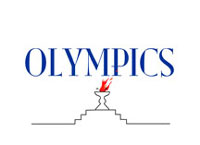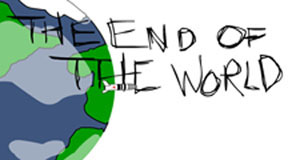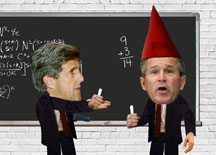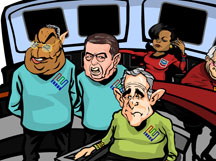 |
→ September 2004 Contents → E-bits
|
E-Bits
September 2004
|
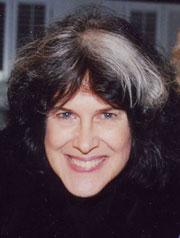 |
|||
|
During the last two and a half decades, the photographic world experienced tremendous and perpetual technological upheaval that has greatly impacted photographers and visual artists, myself included. As a black & white, available-light, editorial photographer, I began to sense the threat of impending extinction by about 1982 or 1983. Until that time, newspapers and weekly news magazines printed images in black and white, and the use of color was relegated to the funny papers. Many photojournalists working in B&W either remained stubbornly so — and experienced the loss of forums for their work — or began shooting in color. Some who were flexible enough turned to the emerging and competitive business of video journalism. My own response to the distressing turn of technological events of that era was to supplement my B&W photographic life with an illustrated diary. Upon viewing my journal, Cornell Capa remarked, "Vith dese cartoons I can say vat I cannot say vith foto." "Right!" I said, for I had discovered a whole new outlet for whatever internal pressures caused me to fall in love with photojournalism in the first place. As in print, photo and video journalism, anything is fair game in the world of illustrated commentary-politics, sports, world affairs. Within the 174 volumes I've created since 1981, the subject matter ranges from dreams, humorous personal interactions and philosophical observations, to world affairs and ponderous attempts from time to time to cover ongoing matters such as the Arab-Israeli conflict, politics, wars and environmental disasters such as Chernobyl. Hence, I have a true appreciation for the world of cartoonists and animators, especially those with a journalistic bent.
Our E-Bits features this month are not digital photos or photographic video clips, but animations and a cartoon that have made their way to many a desktop over email. For those of you who missed the high points of the Summer Games in Athens, we have Bruno Bozetto's OLYMPICS — an animated version of the trials and tribulations of an Olympic athlete named Mr. Otto. Having watched most of the 2004 games, I can affirm that Bozetto encapsulates Mr. Otto's experience in the best tradition of the Warner Brother's ROAD RUNNER cartoons from the 50's and 60's. Chuck Jones (1912-2002), creator of Wile E. Coyote and Pepe le Pew said, "Animation isn't the illusion of life, it is life." That remains to be seen, but it seems fair to say that cartoons and animation, depending on the subject matter, may be classified as metaphorical relatives of visual journalism. Whether you went to Athens last month or glued yourself nightly to the tube to watch the games, or missed them altogether, you'll enjoy OLYMPICS.
Next is an oldie-but-goodie from a couple of years ago, a humorous animated view of how the world might end. I have been unable to find the name of its creator, but if anyone knows who it is, please give the animator our compliments and tell him or her to get in touch. ENDOFWORLD is a hilariously alarming piece that you will want to replay several times.
A lot of you have been receiving the link to the charmingly non-partisan animation of Bush and Kerry politically duking it out through song in a parody of Woody Guthrie's "This Land." Thanks to writers/directors/animators Gregg and Evan Spiridellis, and Jibjab.com for the entertainment.
If you missed THIS LAND on CNN, here it is again.
Our last animation, ENRON'S PRIZE, whose creator is unknown to us, has also been circulating recently, especially among those critical of events leading to the war. I have received it on email from 6 different sources. This animation portrays the entire Bush administration as space cadets on the Starship Enron, discussing pertinent events that are now part of the historical record. Click here to see ENRON'S PRIZE.
Finally, as if time-traveling through digital cyberspace, the following 1971 DOONESBURY by Garry Trudeau has appeared again during the 2004 election season.
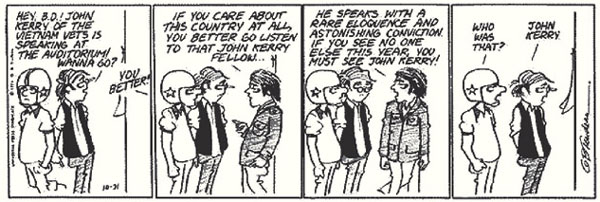
Postscript
Last month "E-Bits" featured a photo of a bull running at Pamplona, and a fascinating, self-produced photo essay of Chernobyl's Dead Zone by a Soviet photographer named Elena. Both features have received comments worth passing on. From all appearances, we could only fear for life and limb of the Pamplona photographer who captured the penultimate "in-your-face" shot. James Hill wrote in to give us the lowdown on the photo of this bovine sprinter:
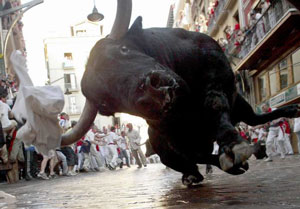
"The bullrun is notoriously difficult to photograph: it takes place at 8 am (bad light) along narrow, shaded streets (even worse light) last seconds and too often the action (the bulls, in other words) are obstructed by the press of runners in the streets. That photo was taken at La Cuerva (or 'Hamburger Corner' as the American contingent like to call it). At this point the route changes direction dramatically: you can see the bull losing its footing. The photographer is at ground level shooting through a narrow gap between the bottom of a barricade and the street. This spot is the only one where the bulls appear to be coming straight at the photographers (due to the sharp curve) and is therefore a popular spot. Great shot. Great luck. And the illusion of danger. Bravo."
After viewing the results from Elena's motorcycle venture through the Dead Zone of Chernobyl and the Ghost Town of Pripyat, another reader, Paul Kent, sent us a reference to Robert Polidori's work on the same subject, ZONES OF EXCLUSION: PRIPYAT AND CHERNOBYL, published by Steidl and Pace/MacGill. The book is a collection of 191 photographs shot on 4X5 of reactor workers and contaminated buildings taken over a period of three days in June of 2001. Kent writes, "I have seen remarkably little press about this book, but did find it in my local independent book store." Explore the link to a short gallery and commentary about the book.
© Beverly Spicer
|
||||
Back to September 2004 Contents |
|

